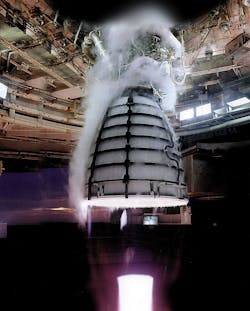RS-25 engine from Aerojet Rocketdyne
RS-25 Engine
Image and information courtesy Aerojet Rocketdyne.
The RS-25, also known as the Space Shuttle Main Engine, is the world’s most reliable rocket booster engine. For three decades, these liquid hydrogen/liquid oxygen engines powered humans and payloads on all 135 Space Shuttle flights, enabling advancements such as the construction of the International Space Station, deployment and servicing of the Hubble Space Telescope, and furthered our scientific knowledge of the Universe. As the nation shifts its vision toward deep space destinations, repurposed and modified RS-25 engines will support initial missions of NASA’s 70-metric ton Space Launch System (SLS). On the SLS, expendable versions of the engine will be used in a cluster of four to provide thrust for the launch vehicle’s core stage. While engines on the shuttle ran at 491,000 pounds vacuum thrust (104.5-percent of rated power level), the power level was increased for SLS to 512,000 pounds vacuum thrust (109 percent of rated power level) to augment the vehicles heavy lift capability. A total of 16 RS-25 flight engines are stored at NASA's Stennis Space Center as teams get ready for testing to begin in summer 2014. Specifications
Quick Facts & Key Milestones
|
